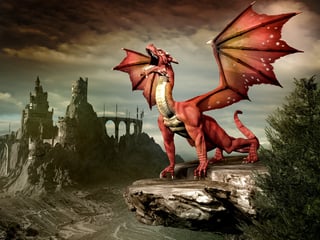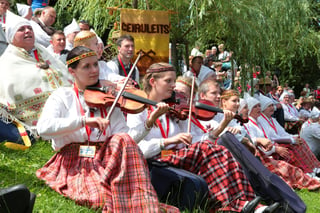A guest post by Bonnie Bright, Ph.D.
 Three of four Americans profess at least one paranormal belief, studies show, including a belief in ghosts, witches, or other magical entities.¹ There is a particular genre of folklore narratives called mythological legends, I recently learned, which are stories relayed as real experiences by real people, and which always involve paranormal elements such as highly unusual animals or ghosts. These specific kinds of folklore narratives are not historical, notes Evija Vestergaard, Ph.D., who researches mythological legends and links them to contemporary culture; rather they are about everyday people and their everyday experiences, which just happen to involve these fantastic creatures or components.
Three of four Americans profess at least one paranormal belief, studies show, including a belief in ghosts, witches, or other magical entities.¹ There is a particular genre of folklore narratives called mythological legends, I recently learned, which are stories relayed as real experiences by real people, and which always involve paranormal elements such as highly unusual animals or ghosts. These specific kinds of folklore narratives are not historical, notes Evija Vestergaard, Ph.D., who researches mythological legends and links them to contemporary culture; rather they are about everyday people and their everyday experiences, which just happen to involve these fantastic creatures or components.
Swiss folklorist Max Luthi speculated on why these two different types of narratives, mythological legends folktales, have co-existed², Evi told me recently in an interview together. While folktales tend to be more heroic, and usually have happy endings, mythological legends tend to be non-heroic. In fact, mythological legends are linked to what is referred to in depth psychology as the “shadow” since they often are about parts of ourselves we wouldn’t want anyone to know about. Either way, there is a “need of the soul” at work in both, which can reveal powerful perspectives on individual shadow, group trauma, and cultural complexes.
 During our conversation, Evi shared a mythological legend related to her own native country and culture of Latvia, which involved a farmer who drove to the capital because he wanted to buy a dragon. The farmer went into a little shop where dragons were sold, the story goes, and the shopkeeper gave him a package wrapped in paper, and told him there was a dragon inside. The farmer gladly paid and left, but on the way home, he got very curious and decided to open the package so he could see the dragon. Upon doing so, he was surprised and disappointed to discover the package contained horse dung instead. The farmer was so incensed, he threw the bundle into the forest.
During our conversation, Evi shared a mythological legend related to her own native country and culture of Latvia, which involved a farmer who drove to the capital because he wanted to buy a dragon. The farmer went into a little shop where dragons were sold, the story goes, and the shopkeeper gave him a package wrapped in paper, and told him there was a dragon inside. The farmer gladly paid and left, but on the way home, he got very curious and decided to open the package so he could see the dragon. Upon doing so, he was surprised and disappointed to discover the package contained horse dung instead. The farmer was so incensed, he threw the bundle into the forest.
Remember, Evi declared upon recounting this tale, this was a true story that actually happened to someone. That is what makes the genre so unique. When she first heard this story, she was reminded of something C.G. Jung said: that Mercurius is found in a dung heap. Mercurius, she points out, is the shadow content of the psyche. It can be both disturbing and repulsive, but it can also be a fertile, nourishing ground for something new.
Evi goes on to relate a dream that she had when she first started researching mythological legends during her studies at Pacifica Graduate Institute. In the dream, she was visiting her father (who in reality passed away when she was 14). Her dream father was cooking some kind of green-brown mass that looked very unappetizing, and she thought to herself (in the dream) that she should go find the “missing ingredient.” Upon contemplating the dream, Evi ultimately interpreted it to mean that she was being given a task by psyche to find out what these mythological legends were really about. What was that green mass, horse dung, or dragon that was hiding in those stories?
 When she first went to Pacifica, Evi told me, she was carrying a question related to her native country, Latvia. Looking back now, she can see how that question was constantly being answered through her research. She feels lucky to have been born Latvian, she contends, because Latvia has such a rich culture with singing, dancing, writing, and painting. She’s very proud of it. However, while the cultural arts and events are remarkable, Latvians seem to struggle as a collective with economics and finances and she really wondered about that. As she was contemplating this question during her dissertation research, a book of mythological legends synchronistically landed on her desk. To her surprise, she found that many of the legends involved the theme of money, and revealed that Latvians have a very complex relationship with money. Mythological legends such as the one she related suggest that wealth is always somehow somewhere else, or with someone else, so you have to go and get it—but it’s not always what you expect it to be. In her research process, she tried to link what was going on in the history of the society with what was going on in the psyche. These stories were generally written during specific historical times, and those who are descendants of the people writing the legends carry the history of the time with them, she affirms.
When she first went to Pacifica, Evi told me, she was carrying a question related to her native country, Latvia. Looking back now, she can see how that question was constantly being answered through her research. She feels lucky to have been born Latvian, she contends, because Latvia has such a rich culture with singing, dancing, writing, and painting. She’s very proud of it. However, while the cultural arts and events are remarkable, Latvians seem to struggle as a collective with economics and finances and she really wondered about that. As she was contemplating this question during her dissertation research, a book of mythological legends synchronistically landed on her desk. To her surprise, she found that many of the legends involved the theme of money, and revealed that Latvians have a very complex relationship with money. Mythological legends such as the one she related suggest that wealth is always somehow somewhere else, or with someone else, so you have to go and get it—but it’s not always what you expect it to be. In her research process, she tried to link what was going on in the history of the society with what was going on in the psyche. These stories were generally written during specific historical times, and those who are descendants of the people writing the legends carry the history of the time with them, she affirms.
Looking at Latvian history, Evi realized, Latvians have been under oppression from Germans, Russians, or Swedes for centuries, and may therefore not feel like they are owners of their place, their country, or any wealth that has existed. Latvians living in a young country that re-established its independence only in 1991 might benefit from information these mythological legends reveal about the complex relationship to money, and how it might inform them moving into the future.
Mythological legends offer a kind of wisdom and opportunity to talk about shadow material through the myths, bringing new life to a process that would otherwise be unpleasant. Mythological legends reveal group trauma through stories that can be viewed similarly to individual dreams. After rereading the stories over and over, Evi believes we can witness trauma but also the traumatic experiences that are required for maturation. Any breaking of established practices and moving on to something new can be traumatic, she notes.
In her recent research, she has recognized a concept that clinical psychologist and Jungian analyst, Donald Kalsched (who works with people who have relational trauma) talks about relating to the dreams of individuals, where mythical beings show up to help individuals “in situations where the external world is too much.”³
Considering Latvia’s history where strong neighbors have frequently invaded to take away what belongs to the land and the people, she views the cultural dynamics similarly to the relational trauma Kalsched talks about. When that kind of dynamic appears, the “helpful” mythical beings in dreams (or in stories, in this case) can become persecutors instead. This is one kind of mythological legend she has identified. Those and the type of stories that evoke the maturation process can both be linked to experiences of synchronicities. Jungian analyst and Pacifica Provost, Joseph Cambray, writes about synchronicities as “breaks in symmetry,” Evi notes. Cambray, who first trained as a chemist, suggests that when complex adaptive systems take new forms, the previous forms have to break.[4] These breaks—often having to do with birth, coming of age, getting married, encountering death, and gaining or losing large sums of money—can be both unpleasant and traumatic, depending on the individual and on the magnitude of the shift.
The reported stories that form mythological legends have to do with the paranormal, Evi reminds me. Jung himself linked paranormal experiences to synchronicities, and reported strange things happening in his own home with doors opening and closing and objects moving around. He described these paranormal experiences as synchronicities where there was seemingly no causal relationship between what occurs in material world and in non-ordinary reality. The stories can also be very disturbing.
To that end, Jungian John Beebe talks about a “trickster art,” where such works can be “perplexing and maddening” as we try to comprehend what’s really going on.[5] The stories can potentially put us in a state of resistance to them, waking us up to a new set of ideas and attitudes. Jungian scholar and professor, Susan Rowland, noted that such stories “break linear judgment” so that we can no longer think the way we thought before, changing the way we relate to things. Evi actually often experienced this trickster element during her research, noticing confusion in herself when reading the stories, especially when keeping in mind that the person who originated the story actually told it as an actual happening. Even the folklorists have struggled with this aspect, she notes, especially as they are still attempting to define this particular genre of folklore where meaning, like a “tricky butterfly,” seems to fly away. This is where depth psychology can help, Vestergaard believes, because when we begin to look them psychologically, we no longer need to struggle to understand whether they are true or not, because it’s a reality for the psyche.
Our culture seems hungry for otherworldly characters and also for magic, which especially seems to be coming through our contemporary literature and film, I point out. Evi agrees that in the United States in particular, which is currently a focus of her research, she sees evidence of fairy tale endings showing up in modern ways, especially a kind of “they lived happily ever after” mindset. Mythological legends are almost the opposite, she suggests, because they don’t hasten the reader or listener to a happy ending, but rather insists they be more reflective and actually think about “what happened on the road to the happy ending.”
In mythological legends, there is not the same push to get to a successful end where there is a clear answer or a clear winner in the story, but they encourage one to stay in a space of confusion or not knowing; to stay with the tension of the question —a state which, for most of us, can feel very uncomfortable and which we often try to avoid. This type of narrative is an expression of the soul’s need, Evi reminds me, so it would be helpful if mythological legends could be more prevalent and receive more attention in modern society. Through relatedness to the mythical beings that appear in the stories, we can create a better relationship with ourselves and with the world around us.
Jung wrote, “In the case of the individual, the problem constellated by shadow is answered on the plane of the anima”—that is, through relatedness, Evi notes. In these stories, the same thing comes through. When we can communicate with those “parts of ourselves that are those strange beings,” that is when we become “rich”—when we can hold onto the wealth and feel valued and worthy.
In closing, Evi speaks to her experience of the research process, and how it offered a wealth of validation and support. There is no other place like Pacifica, she insists: not only does Pacifica support rigorous academic research, it also advocates research that comes through the body and the psyche, through dreams and active imagination. Some of the faculty at Pacifica have devised entirely new methods of research, Evi reports, including a method conceived by Susan Rowland which combines active imagination with “close reading,” allowing the researcher to see not only from a cultural and historical perspective, but also from the perspective of the psyche. Pacifica brings tremendous value and allows researchers to return that value through their research to the world and to other researchers who come after them, Evija insists. As for me, I’m inspired.
[1] Gallup poll, June 2005: http://www.gallup.com/poll/16915/three-four-americans-believe-paranormal.aspx
[2] View books by folklorist Max Luthi at https://www.amazon.com/s?ie=UTF8&page=1&rh=n%3A283155%2Cp_27%3AMax%20Luthi
[3] See Kalsched, Donald. 1996. The Inner World of Trauma: Archetypal Defences of the Personal Spirit, Routledge, New York, NY.
[4] See Cambray, Joseph. 2012. Synchronicity: Nature and Psyche in an Interconnected Universe, Carolyn and Ernest Fay Series in Analytical Psychology, TAMU Press.
[5] See John Beebe’s essay, “The Trickster in the Arts,” San Francisco Jung Institute Library Journal, vol. 2, no. 2 (1981): 48
Listen to the full audio interview with Evija Vestergaard, Ph.D. here (approx.34 mins):
Find out more about Jungian and Archetypal Studies specialization at Pacifica here-->
 Evi Volfa Vestergaard (Evi) holds a Ph.D. in the Jungian and Archetypal Specialization of the Depth Psychology Program from Pacifica Graduate Institute. She is an independent researcher interested in a particular type of cultural narrative—the mythological legend that reports human encounters with the extra-human world manifesting in the ordinary world of reality. Evi has found the mythological legend to be an expression of a particular need of the soul. It has to do with individual and group trauma, personal shadow material, and cultural complexes. She believes that the mythological legend is an untapped source of insight that can tell us about cultures in ways that we are unlikely to learn from other forms of literature or art, or from history books. In today’s world of unrests and conflicts we can always use an added insight about groups. Evi trusts that it is important to hear the communications of the soul if we are to relate to each other with a greater understanding and compassion.
Evi Volfa Vestergaard (Evi) holds a Ph.D. in the Jungian and Archetypal Specialization of the Depth Psychology Program from Pacifica Graduate Institute. She is an independent researcher interested in a particular type of cultural narrative—the mythological legend that reports human encounters with the extra-human world manifesting in the ordinary world of reality. Evi has found the mythological legend to be an expression of a particular need of the soul. It has to do with individual and group trauma, personal shadow material, and cultural complexes. She believes that the mythological legend is an untapped source of insight that can tell us about cultures in ways that we are unlikely to learn from other forms of literature or art, or from history books. In today’s world of unrests and conflicts we can always use an added insight about groups. Evi trusts that it is important to hear the communications of the soul if we are to relate to each other with a greater understanding and compassion.
 Bonnie Bright, Ph.D., is a graduate of Pacifica’s Depth Psychology program, and the founder of Depth Psychology Alliance, a free online community for everyone interested in depth psychologies. She also founded DepthList.com, a free-to-search database of Jungian and depth psychology-oriented practitioners, and she is the creator and executive editor of Depth Insights, a semi-annual scholarly journal. Bonnie regularly produces audio and video interviews on depth psychological topics. She has completed 2-year certifications in Archetypal Pattern Analysis via the Assisi Institute and in Technologies of the Sacred with West African elder Malidoma Somé, and she has trained extensively in Holotropic Breathwork™ and the Enneagram.
Bonnie Bright, Ph.D., is a graduate of Pacifica’s Depth Psychology program, and the founder of Depth Psychology Alliance, a free online community for everyone interested in depth psychologies. She also founded DepthList.com, a free-to-search database of Jungian and depth psychology-oriented practitioners, and she is the creator and executive editor of Depth Insights, a semi-annual scholarly journal. Bonnie regularly produces audio and video interviews on depth psychological topics. She has completed 2-year certifications in Archetypal Pattern Analysis via the Assisi Institute and in Technologies of the Sacred with West African elder Malidoma Somé, and she has trained extensively in Holotropic Breathwork™ and the Enneagram.



